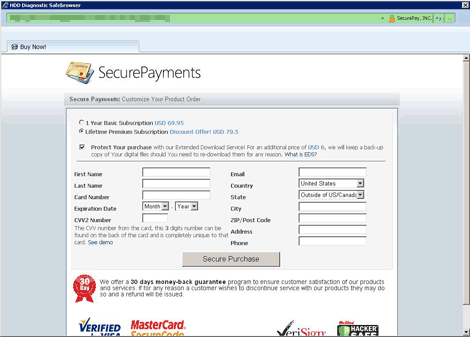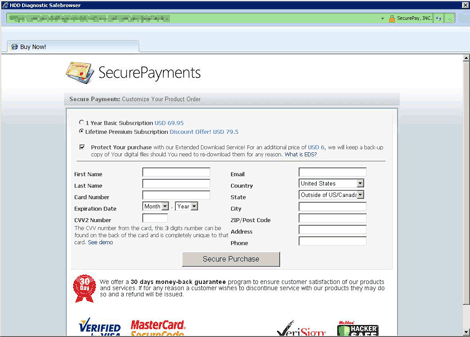TROJ_FAKEAL.CG
Microsoft: Trojan:Win32/FakeSysdef; Kaspersky: Trojan-Dropper.Win32.FrauDrop.boo
Windows 2000, XP, Server 2003


Threat Type: Trojan
Destructiveness: No
Encrypted: Yes
In the wild: Yes
OVERVIEW
It is a fake system diagnostic tool that tricks users into thinking that it is a legitimate program capable of searching for errors and issues on the affected system. Upon execution, it displays a convincing user interface (UI). It then asks the user to activate the product to fix the errors . If users decide to purchase the product, users are redirected to a website asking for sensitive information such as credit card information.
This Trojan may be dropped by other malware. It may be unknowingly downloaded by a user while visiting malicious websites.
TECHNICAL DETAILS
Arrival Details
This Trojan may be dropped by other malware.
It may be unknowingly downloaded by a user while visiting malicious websites.
Installation
This Trojan drops the following non-malicious files:
- %User Temp%\dfrg
- %User Temp%\dfrgr
- %User Profile%\Start Menu\Programs\HDD Diagnostic\HDD Diagnostic.lnk - shortcut to the dropped copy
- %User Profile%\Start Menu\Programs\HDD Diagnostic\Uninstall HDD Diagnostic.lnk - shortcut to the dropped copy
- %User Profile%\Desktop\HDD Diagnostic.lnk - shortcut to the dropped copy
(Note: %User Temp% is the current user's Temp folder, which is usually C:\Documents and Settings\{user name}\Local Settings\Temp on Windows 2000, XP, and Server 2003.. %User Profile% is the current user's profile folder, which is usually C:\Windows\Profiles\{user name} on Windows 98 and ME, C:\WINNT\Profiles\{user name} on Windows NT, and C:\Documents and Settings\{user name} on Windows 2000, XP, and Server 2003.)
It drops the following copies of itself into the affected system:
- %User Temp%\{random numbers}.exe
(Note: %User Temp% is the current user's Temp folder, which is usually C:\Documents and Settings\{user name}\Local Settings\Temp on Windows 2000, XP, and Server 2003.)
It creates the following folders:
- %User Profile%\Start Menu\Programs\HDD Diagnostic
(Note: %User Profile% is the current user's profile folder, which is usually C:\Windows\Profiles\{user name} on Windows 98 and ME, C:\WINNT\Profiles\{user name} on Windows NT, and C:\Documents and Settings\{user name} on Windows 2000, XP, and Server 2003.)
Autostart Technique
This Trojan adds the following registry entries to enable its automatic execution at every system startup:
HKEY_CURRENT_USER\Software\Microsoft\
Windows\CurrentVersion\Run
{malware name} = %User Temp%\{random numbers}.exe
Other Details
This Trojan does the following:
- It is a fake system diagnostic tool that tricks users into thinking that it is a legitimate program capable of searching for errors and issues on the affected system.
- Upon execution, it displays the following UI:

- It then asks the user to activate the product to fix the errors.

- If users decide to purchase the product, users are redirected to the following website asking for sensitive information such as credit card information:
- http://{BLOCKED}jewel.org

SOLUTION
Step 1
For Windows XP and Windows Server 2003 users, before doing any scans, please make sure you disable System Restore to allow full scanning of your computer.
Step 2
Identify and terminate files detected as TROJ_FAKEAL.CG
- If the detected file is displayed in either Windows Task Manager or Process Explorer but you cannot delete it, restart your computer in safe mode. To do this, refer to this link for the complete steps.
- If the detected file is not displayed in either Windows Task Manager or Process Explorer, continue doing the next steps.
Step 3
Delete this registry value
Important: Editing the Windows Registry incorrectly can lead to irreversible system malfunction. Please do this step only if you know how or you can ask assistance from your system administrator. Else, check this Microsoft article first before modifying your computer's registry.
- In HKEY_CURRENT_USER\Software\Microsoft\Windows\CurrentVersion\Run
- {malware name} = %User Temp%\{random numbers}.exe
- {malware name} = %User Temp%\{random numbers}.exe
Step 4
Search and delete this file
Step 5
Search and delete this folder
- %User Profile%\Start Menu\Programs\HDD Diagnostic
Step 6
Scan your computer with your Trend Micro product to delete files detected as TROJ_FAKEAL.CG. If the detected files have already been cleaned, deleted, or quarantined by your Trend Micro product, no further step is required. You may opt to simply delete the quarantined files. Please check this Knowledge Base page for more information.
Did this description help? Tell us how we did.

